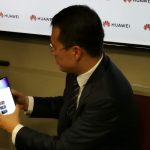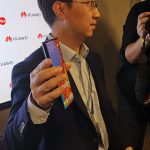After the launch of the Huawei Mate X this morning, we’ve had the opportunity to spend a bit more time with the device and catch up with some of the key executives involved in the development of the product.
Unsurprisingly, and perhaps a bit disappointingly, the handsets remain very, very closely held. While we’ve been able to see (close up) how the handsets work and some of the key features, Huawei has been very clear in ensuring no one besides key Huawei personnel are allowed to actually handle the devices.
With that preface out of the way, let’s walk through some of the more nuanced features of the Huawei Mate X – what follows is some information from the interview sessions as well as some demos.
A main concern that customers will have about this device, being that it’s quite expensive, is how well protected it is against damage. As the display is not a glass product – it’s a polymer-type softer display, obviously – the question is how will it hold up to daily life? Would it break if dropped, for example. How would it handle a puncture (e.g. being dropped on a rock or pointed surface)?
Huawei’s Bruce Lee, Product Manager for Handsets, admitted that the foldable display technology as it stands today is not as robust as the tried and tested glass displays we’re familiar with. For example, being flexible the display is more susceptible to being punctured or broken from sharp impacts, and this is part of the motivation for developing a strong first-party case for the device, which also leaves the phone perfectly usable.
This does lead to the obvious concern about the price. Huawei has made clear that this price is driven primarily by the cost of the component parts and recovering the cost on research and development rather than purely profiteering on what may prove to be a popular device. Mr Lee acknowledged, though, that economies of scale are yet to be fully explored for Mate X components, and that in future it’s expected the price will drop rather than go up.
We sought further information about the time-frame for release, given the presentation was a bit light on detail. The reality is, Huawei don’t have a clear time-frame for release just yet – the technology is very new, and one suspects the tooling up for production hasn’t gone too far just yet – so while there’s a soft estimate for mid year, this depends on a lot of variables. The main variable identified was appropriate network development in target markets; where 5G networks aren’t deployed, Huawei isn’t targeting the market.
The example of India was discussed and the strategy was telling; while the Mate X supports 3G to 5G in one device, 5G is the focus and so the product will not (at this stage, at least) be released in markets without a 5G presence.
A lot of questions were asked about the partners Huawei has worked with to develop the Mate X from a software perspective, and though some of these partners are clear (Huawei has worked with Google, for example, to ensure that software support for the foldable form factor is in place), some were less so. Mr Lee did concede, though, that Huawei was working with major app developers (e.g. Facebook, Netflix, Instagram etc) to ensure that popular apps would work in a logical and useful way on the foldable display.
Huawei was asked about what compromises it had to make to build the Mate X. This was an interesting question, because both Mr Lee and Tom Chen were of the opinion that there weren’t any; it wasn’t a case of compromise to get the Mate X ready for launch, rather a case of design challenges which had to be met. For example, how to fit a USB-C port on such a thin device (put it on the thicker part), how to incorporate sufficient battery into the thin device (use two, one in each side) and so on. An interesting side effect of using the battery placement this way is that – perhaps quite unintentionally – the Huawei Mate X is able to operate in very low temperatures, by avoiding thermal shutdown due to unstable battery voltage in low operating temperatures.
Overall, though, Huawei didn’t view the Mate X as a compromise at all; it’s both the first 5G foldable phone shown off, but it’s also going to be every bit the equal of the P-series and Mate series phones when it’s folded.
This was also touched on in the presentation itself; Huawei’s Mate X features a proper smartphone-sized display when folded, instead of a smaller compromised size. This was quite evident in the hands-on demonstrations too – even when folded, this is a great phone.
Last but not least, we were treated to some demonstrations on how the Mate X is to use in real world situations. Web browsing on the larger screen is much easier – making reading more intuitive with less scrolling – and watching YouTube videos allowed full-screen display when unfolded, and when folded up, it reverts back to a normal smartphone-style display.
All in all, it remains clear that – for now – the Mate X is very much a work in progress. In the development lifecycle, it’s most probably at the minimum viable product stage, but that’s not good enough for Huawei to move to release.
Going back to that word – compromise – to release it in it’s current form would be exactly that, and Huawei just doesn’t want to go down that path. Instead, Huawei’s Kevin Ho (President, Handsets Division) made clear that Huawei would take the time to get the product right, polish the software and develop the user experience such that – when the Mate X does go on sale – it’s the best offering possible.
Let’s face it. For almost $4,000 AUD on the pricing given, the Mate X needs to avoid compromises. Few will forgive mistakes at that price.












It’s really quite odd that they do an outer fold when they’ve admitted the screen is less durable.
Outer fold means that the two halves of the phone can meet perfectly when closed. Inner folds end up with the weird air-gap along the inner fold edge.
That seems to be the consensus. Huawei Mate X folds virtually flat – just 11mm thick and no air-gap as such. Galaxy Fold does have that small space to avoid effectively breaking the screen in half.
The screen they’ve demonstrated at MWC isn’t the final material design, we’re told. The screen is somewhat durable, but their handset division president made clear they were still looking for further refinements to the plastic composition to make it a bit hardier. Plus, the specially designed case will keep things fairly safe … but it won’t be the kind of device where a screen protector will be available, you’d think.